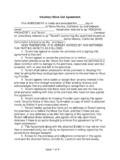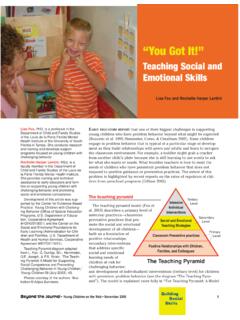Transcription of PLOUGHING GUIDE - KvernelandGroup
1 PLOUGHING GUIDE . by Alan Jones Kverneland Group UK Ltd. The secret of successful PLOUGHING :- Correct maintenance, preparation and plough settings Quick GUIDE Before you can achieve good PLOUGHING it is essential that both the tractor and plough are properly prepared. The tractor should have the correct wheel set- tings and, if using a reversible plough, equal tyre pressures on both axles. Tractor front-end ballast may be required for stability but most important, effi- cient operation of the tractor's hydraulic system. The Tractor Tyre pressure must be equal on the same axle for all reversible ploughs Hydraulic male & female couplings must match to avoid back pressure Enough hydraulic outlets must be available to operate all plough functions The inside wheel settings must be equal, especially when using 4WD tractors Rear 3-point linkage lift arms must be equal in length on reversible ploughs Adequate horsepower for the size of plough is essential for optimum performance Correct linkage geometry is essential Cat II, Cat III or Cat IV for correct line of pull Traction, stability and operation of hydraulic functions rely on adequate weight Operation controls in the tractor must be selected to Draft' or Mix'.
2 Rigid stabilisers are essential for correct operation of semi-mounted ploughs In The Field Important, always set disc coulters before skimmers for optimum performance Never set skimmers deeper than 10cm and ensure all operate at the same depth Test and adjust the plough's furrow width to the suit soil type being ploughed Hydraulic functions must be checked prior to work for compatibility and operation Ensure depth wheel adjusters are equal in length on reversible ploughs Front furrow depth is set by the tractor's in-cab 3-point linkage control Inclination of the plough will cause uneven furrows plough leg to be 90 to the land 0. Ensure the front furrow width is equal to the plough setting for even furrows Look closely for equal amounts of soil on mouldboards for furrow uniformity Demonstration and operational success only follows good plough preparation Know Your Plough Headstock Plough body Disc coulter Plough leg Cross shaft Main frame Skimmer Alignment/Vari-Width cylinder Vari-Width linkage Depth wheel Plough Body Parts 12.
3 16. 7 8 13 1 14. 15. 9. 3. 6 10. 2. 11. 5. 5 4. 1. Landside 9. Mouldboard stay 2. Saddle (frog) 10. Sword share knife 3. Shin piece 11. Flush fit point (for sticky soils). 4. Reversible point 12. Trashboard 5. Share (flush fit & reversible point) 13. Trashboard mounting bracket 6. Mouldboard 14. Skimmer mouldboard 7. Mouldboard extension 15. Skimmer share 8. Mouldboard stay bracket 16. Skimmer stalk Know Your Plough Headstock Furrow splitter Mouldboard extension Skimmer (maize type) Sword share knife Sword landside Disc coulter Trashboard Ecoshare Furrow bottom widener Rear depth wheel Combined depth &. transport wheel Tractor Settings +0-10cm Tractor wheel setting The front and rear inside wheel setting of the tractor is very important. Initially, they control the front furrow width of the plough. As the wheel setting is in- creased, the centre line of the tractor moves away from the furrow wall, thus increasing the width of the front furrow.
4 Reducing the wheel setting has the op- posite effect and narrows the front fur- row width. When PLOUGHING with the tractor wheel in the furrow bottom, the tractor will lean towards the ploughed land. This is exag- gerated when operating at depths above 8in. To ensure the tractor and plough pull in a straight line, it is recommended 110-160cm to adjust the front wheels 0-10cm wider than the rear. However, when using a Incorrect adjustment Correct 4WD tractor or when PLOUGHING less than 7in deep, equal front and rear wheel settings can be advantageous as it helps to ensure the tractor and plough pull in a straight line. Front furrow width During operation and with the tractor having the correct wheel setting for the plough being used, the front furrow width should be equal to all the remain- ing furrows.
5 As it is impractical to contin- uously adjust the wheel setting, the plough is provided with a side shift sys- tem to simplify this adjustment. See Basic Field Settings'. Tractor 3-point linkage geometry For efficient plough operation and stabil- ity, it is essential that the tractor's 3- point linkage geometry and pulling point is correct. Incorrect linkage geometry will cause the plough to wander from side to side and can also affect the tractor's stability and performance. Tractor linkage geometry will depend on the type of linkage category fitted. Cross shaft length: Cat II = 825mm, Cat III = 965mm Cat IIIN = 825mm, Cat IV = 1165mm Cat IVN = 965mm (Special Cat III 860mm shaft available for Cat IIIN linkage). TIP! This measurement is taken from the inside of the tractor link arm ball ends when fitted to an implement.
6 Plough Alignment For a plough to work efficiently, all the bodies must be correctly aligned and par- allel to one another. Incorrect settings will result in poor quality work and une- ven component wear. Poor alignment will also cause the plough to pull out of line and affect the tractor steering. Furrow width Using a straight edge against the rear landside, check the furrow width of each body. All bodies should be paral- lel to each other. 2X Always ensure the plough is fitted with X new wearing parts for accurate meas- urement. Underbeam clearance Using a rule from the underside of a new point to the underside of the main frame. Left hand bodies should be equal to right hand bodies on a reversible plough. X2 Interbody clearance The body inlet should be equal to the X3 outlet X1 = X2. X3 Left bodies must be equal to right bod- ies on reversible ploughs.
7 Measure from a non-wearing datum and then X1 chalk a mark on the end of the mould- Chalk mark boards X3. Adjust the mouldboard rear stays to correct setting X2. See: Mouldboard Adjustment'. Mouldboard height Using your eyes or string, the tops and bottoms of the mouldboards should be in a straight line. Adjust by slacken- ing the mouldboard and stay bolts to correct. Mouldboard Adjustment Before you can achieve good PLOUGHING , it is essential to check and adjust the mould- board interbody clearance setting. This is to ensure that all the furrows are equal in size and height during operation. Marking the mouldboards Chalk mark each mouldboard end (both left and right) to find a common datum'. point to work from. The measurement should be taken from a non wearing point such as the joint between the share, mouldboard and shin piece as indicated.
8 Adjusting right hand mouldboards Datum chalk Starting from the centre body, loosen the marks mouldboard stay and adjust so that the Master mouldboard is in a neutral position - not pushed forward or pulled back. This is now the master' for all mouldboard measurements. Measure accurately from the datum'. chalk mark on the master mouldboard to the chalk marks on the mouldboards in front and behind. Adjust the mould- board stays accordingly so that the mouldboard spacing is equal to the inter- body clearance. TIP! If the interbody clearance is not known, take this measurement from any common point on the main plough frame or leg assembly. Master RH Bodies Adjusting left hand mouldboards To adjust the left hand bodies on a re- X1. versible plough, the right hand mould- board throw' has to be known. Using a tape measure note the distance from the datum' chalk mark on the right hand master' mouldboard to the leg on the body assembly behind X1.
9 Setting the throw' on the left bodies Repeat the above adjustment on the left hand bodies and adjust the centre mouldboard stay so that the throw' is equal to the right hand side X1. Now adjust the left hand mouldboards in turn, using the centre body as the new X1. left hand master'. Measure from the chalk mark on each mouldboard. The mouldboard stay is adjusted accordingly Master to achieve the correct setting. LH Bodies Correct mouldboard adjustment is cru- cial to uniform PLOUGHING . Basic Field Settings Disc coulter The disc coulter should be set in a verti- cal position and 1-2cm wider than the furrow width. Depending on soil condi- tions, the working depth should be be- tween 4 -10cm maximum. When working in light soil conditions it may be advantageous to widen the disc coulter to produce a clean furrow wall.
10 Skim coulter 3-5mm The skim coulter should work as close to the disc as possible without touching and adjusted with a gap of 3-5mm at the top to prevent trash build-up. The work- ing depth should be set between 2-5cm maximum. If set too deep, the furrows will be left open and cause unnecessary trash growth. Frame setting The plough should be adjusted so that the frame is parallel with the ground and all the bodies PLOUGHING at the same depth. Adjustment is carried out by means of the tractor top link or tractor 3- point linkage. Frame setting conventional plough The plough legs should be set 90deg to the land when in work. Adjustment is by means of the tractor right hand levelling box. 90deg TIP! Do not adjust the front furrow width unless this setting is correct. Frame setting reversible plough Similar to the conventional plough, but the adjustment is by means of the wing (level) adjuster on the plough headstock.



